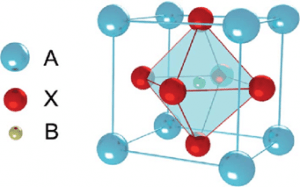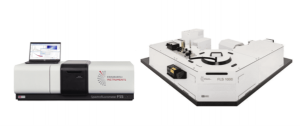In this article, Edinburgh Instruments will investigate the most promising perovskite applications to improve current technologies. Since their discovery 180 years ago, perovskites have been well researched, and in recent years, applications of perovskites have increased significantly due to their many useful properties.
What is a Perovskite?
First discovered in 1839, perovskite is a mineral formed of calcium, titanium and oxygen with the chemical formula CaTiO3. Since then, minerals with the same general formula (ABX3) and similar structural formula (Figure 2) have been found in abundance on earth, although most perovskite research is carried out with synthetic materials. Materials with the formula ABX3 are known as perovskite materials, but often just referred to as perovskites.
Figure 1: Perovskite mineral, first found in 1893
In recent years, research in perovskite materials has significantly increased due to their favourable properties, providing a real interest in the potential applications of perovskites. These include, but are not limited to:
- Superconductivity
- Catalytic properties
- Opto-electronic properties
Figure 2: General Structure of a Perovskite
What are the Applications of Perovskites?
There are several industries with interest in perovskites applications that are undertaking research to improve the technology. Two industries with particular interest in perovskites are photovoltaics and opto-electronics:
- Photovoltaics
Perovskite materials offer a promising alternative to traditional silicon solar cells as they are more tunable and cheaper to manufacture. In recent years, efficiency of perovskite based solar cells has increased to a lab efficiency of over 25%, showing great commercial promise. Research is still on-going to improve the robustness and longevity of these solar cells.
Figure 3: A huge potential application of perovskites is in solar cell technology.
Read about Edinburgh Instruments work with perovskites in photovoltaics here.
2. LEDs
Whilst LEDs have been known for decades, perovskite-based LEDs offer the next generation in this technology. The optoelectronic properties of perovskite materials such as tunability, high photoluminescence quantum yield and cheaper manufacturing have captured the interest of many researchers and technology companies alike.
Figure 4: LEDs can be greatly improved with perovskite technology.
You can read more about Edinburgh Instruments’ work with perovskites and LEDs here.
Edinburgh Instruments’ work with Perovskites
Edinburgh Instruments applications team have run various experiments with perovskites using FLS1000 Photoluminescence Spectrometer and FS5 Spectrofluorometer. You can read about these, and the other uses of Edinburgh Instruments in the Application and Technical notes.
Figure 5: FS5 Spectrofluorometer and FLS1000 Photoluminescence Spectrometer
Original article published: https://www.edinst.com/blog/perovskite-applications-improving-todays-technology/








